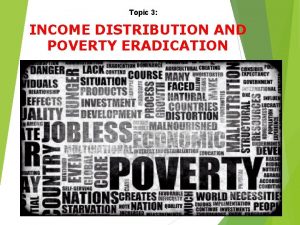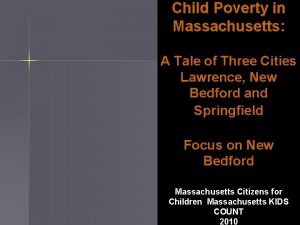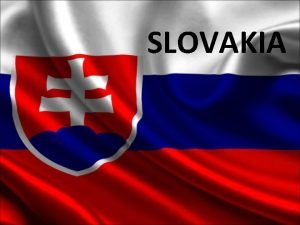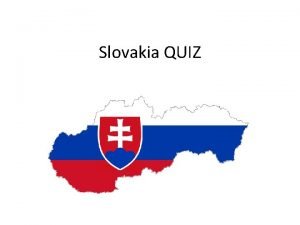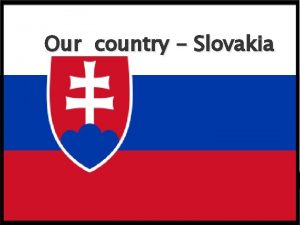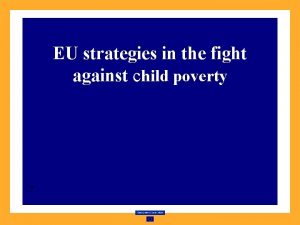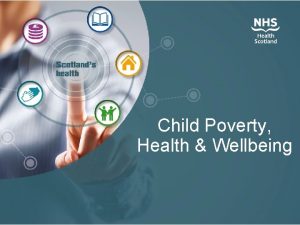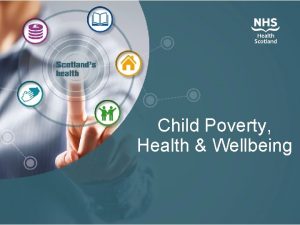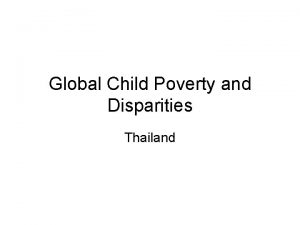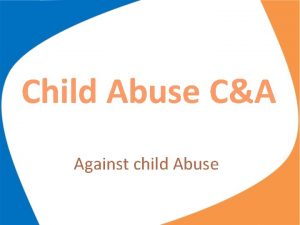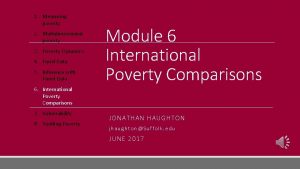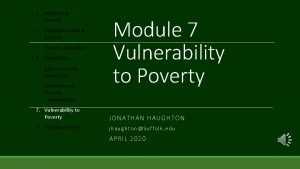Fight against Child poverty in Slovakia How we















- Slides: 15

Fight against Child poverty in Slovakia How we are doing? The first four years of the Szécsény children´ program to combat child poverty Szécsény, 29 April 2011 Zuzana Kusá Slovak Anti. Poverty Network

Main themes of presentation • Public opinion about poverty (and ethnicity) and antipoverty programmes • Facts about poverty • Policies against poverty

Public opinion about poverty of children Surveys show that Slovaks have big concerns about situation of children growing in poor families. Surveys also show that Slovaks have only little concern about situation of Roma in Slovakia. Slovak politicians know that their voters perceive antipoverty programs as privileging Roma to majority population.

Facts on poverty of children in Slovakia § More than 10% of Slovak children are growing up in jobless households § Poverty and poverty of children has strong regional character § Children from jobless households dominate among pupils who do not finish compulsory education or do not continue in education § Material deprivation exceeeds monetary poverty § Part of facts about child poverty is hidden (poor household concentrations are avoided by surveys (included EU-SILC)

Development of risk of poverty of social groups in SK (EU-SILC)

Number of persons under the poverty threshold (by household with different number of dependent children (EU-SILC 2009)

Burden of paying housing costs by type of household EU-SILC 2009

Economic status of parents of pupils by pupil´s ethnic origin Krásne (town in south-eastern Slovakia with 28% registered unemployment) Slovak father Hungarian mother father Roma mother father mother Full-time job 76 72 68 64 21 14 Part-time job 3 5 9 10 8 5 retired 2 3 7 0 2 2 Parental leave 0 3 0 5 2 12 unemployed 19 17 16 21 68 67 total 100 100 100 7 FP No. 217384 EDUMIGROM

Reforms of minimum income (last resort) scheme • 1990 – 1998 household minimum income secured on the subsistence minimum level (SM was not appropriately uprated) • 1999 benefits to long-term unemployed halved but total benefit for household secured subsistence minimum to children • 2003, the ceiling of 10, 500 SKK (EUR 309) set for monthly benefit per household irrespective of the number of children. • 2004 benefit divided to „solidary“ and „merit“ part and is more firmly tied to household; jobless singles under 25 are not entitled to benefit if they live in their parents’ household. Benefit is cut off if any of the household member leaves Slovakia. All merit alllowances are cut off for six months if beneficiary does not fulfil some of her/his duties. • 2112 reform is expected to reduce solidary part further (to secure one hot meal daily)

Relation of basic MI benefit and MI maximum benefit to the national poverty threshold for selected types of households in euro 1 adult Number of children 0 0 2 adults 1 – 4 children 1 2 National PT 185 270 Basic benefit 60, 5 115, 1 Maximum benefit with allowances 182 311 Difference NPT – max. benefit -3 31 3 4 0 1 – 4 children 0 1 2 354 439 523 314 399 483 570 652 737 822 115, 1 1 105, 157, 6 2 6 115, 1 351 391 432 326 -3. 3 12 -48 -91 419 20 3 4 5 and more children 5 157, 202, 6 6 3 6 202, 3 459 500 540 635 649 -24 -70 -112 -102 -172

Conditionality of the allowances to basic MI benefit Conditionality Activation allowance Registered job-seekers, taking part in activation work, (since 2008, limited to 6 months and one time), studying while caring for a child to 3 or 6 years of age Allowance for pregnant Since the fourth month of pregnancy - visits of gynaecologist documented on the pregnancy card Protection allowance Reaching the age of entitlement for an old age pension, disability, lone parent caring personally for a child until 31 weeks of age, illness Housing allowance Regular (6 month) payments of rent and/or housing services, proof of ownership or a renting contract or the right to life-long usage; those who live in temporary housing facilities are not entitled Health contribution Fulfilling commitments of beneficiaries Allowance for parents caring for a child younger than one year Confirmation from a paediatrician that the child has taken part in preventive medical examinations Benefit for child that is fulfilling compulsory school attendance Regular school attendance (since 2009)

Elementary school welfare programmes Since 2004 Ø school meals for children from poor households (usually only MI beneciaries), small cofinancing of parents was required till 2011. Now free of charge. Ø school supplies for children from poor households free of charge Ø Motivation scholarship – in 2009 replaced by allowance for regular school attendance paid by labour office (only MI beneciaries)

System problem in school policy Insufficient financing Missing goal and cooperation morale Large classes hamper individual approach and force to „frontal“ teaching that is not sensitive to differences in pupil´s abilities; Low number of teacher assistants (only schools with 100 and more pupils from socially disadvantaged environment have duty and resources to establish TA) Hindrances to free time activities of poor children • Missing municipal and school strategies of poorest children integration (mixed education, free time activities) • Rare cooperation of schools and NGOs • Fatalistic approach to Roma education • Opinion that minimum income system is generous and demotivating also prevails among teaachers

Responsibility for promotion of equal opportunities for children on the central government level Ø There are several high quality strategies on the governmental level (such as the Program of comprehensive development of marginalised Roma settlements approved in 2002) Ø There are even tools prepared (horizontal priority of Roma marginalised settlements for the Programming period 2007 – 2013 Ø There is discontinuity of the political will after every election; Ø There is the tendency to accuse equalising measures for being form of discrimination Ø There is the interest to comply with, promote and capitalise individual responsibility ethos of Slovak population

Last and lasting question: how to deal with the dilemma of targeted antipoverty programmes that raise hostility of poor families towards poorest ones and are undermined by it universal programmes in favour of all children that would further raise deficit and indebtedness (and in the era of fiscal consolidation) seem unfeasible
 Distinguish between absolute poverty and relative poverty
Distinguish between absolute poverty and relative poverty Jack sparrow adidas
Jack sparrow adidas Rizal in london paris brussels and madrid
Rizal in london paris brussels and madrid Child poverty in massachusetts
Child poverty in massachusetts Definition of child labour
Definition of child labour Easter in slovakia
Easter in slovakia Hacoslovakia
Hacoslovakia Slovakia heart of europe
Slovakia heart of europe Freedom cave slovakia
Freedom cave slovakia Slovakia christmas traditions
Slovakia christmas traditions Whip-cracking in the czech republic and slovakia
Whip-cracking in the czech republic and slovakia Slovakia aquapark
Slovakia aquapark What is the name
What is the name Transpetrol slovakia
Transpetrol slovakia Facts about slovakia
Facts about slovakia Slovakia my country
Slovakia my country
